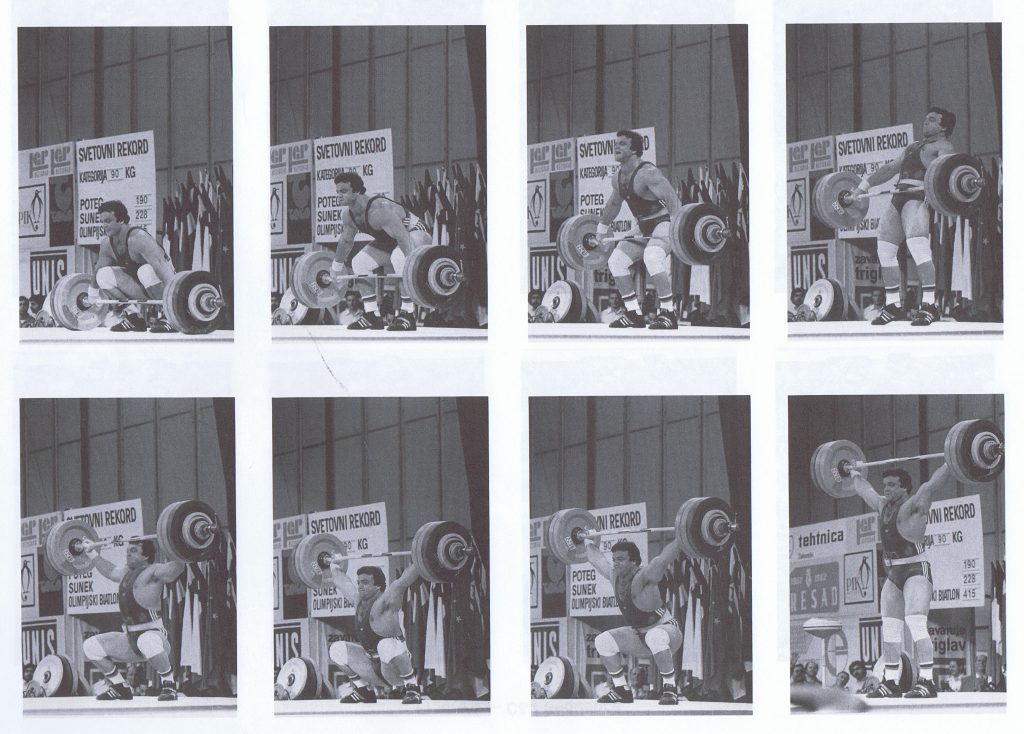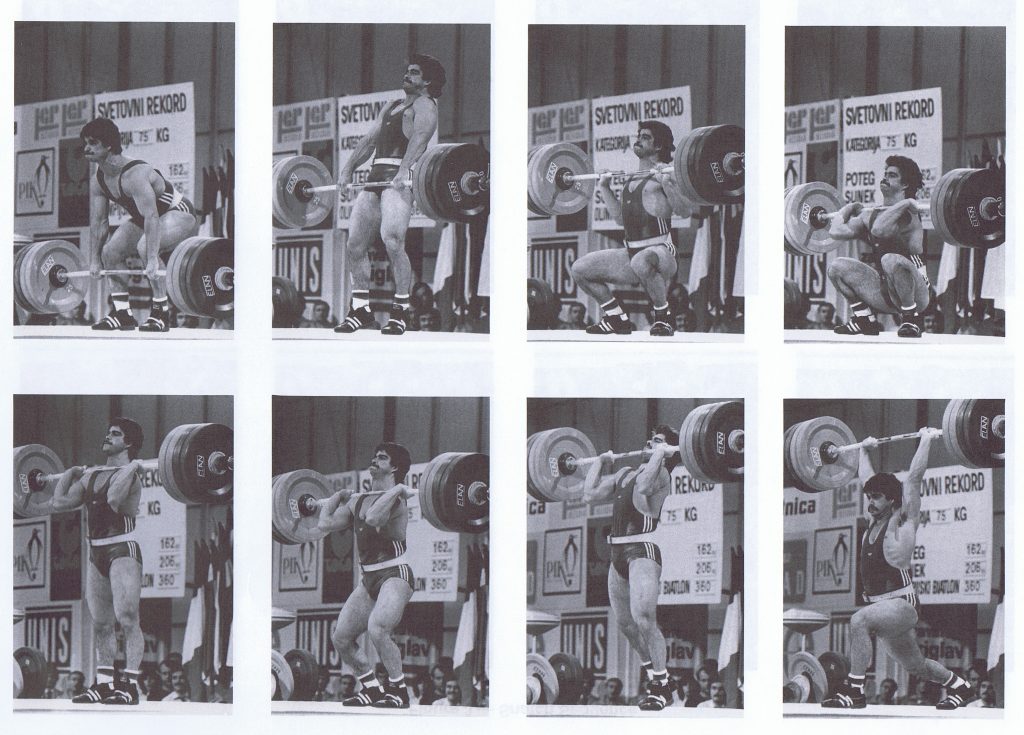Olympic-Style Weightlifting
Olympic-Style Weightlifting (or “Weightlifting”, as the sport is called in the Olympic Games) is the oldest and most universally practiced sport in the world involving barbells and tests of strength. Part of the Olympic Games at the inception of the modern Games in 1896, the Weightlifting event’s winners have proudly earned the title of the Strongest Man and Woman in the World (and also the most powerful – power being a function of speed and strength). Weightlifting is the only sport involving heavy weights in the Olympic Games.
Weightlifting competitions consist of two events in which a barbell is lifted overhead – the “Snatch” and the “Clean & Jerk”. Each athlete is permitted three “attempts” in each of these lifts and his or her highest successful lift in each of these events is aggregated to arrive at the lifter’s “Total”. The lifter with the highest Total wins the competition. Competitions are conducted with eight body weight categories for men and seven for women. Many competitions have specific categories which take into account the athlete’s age. Therefore, in the sport of weightlifting, you are able to compete against athletes your own size, age and gender.
In the Snatch lift, the athlete lifts the barbell from the floor to arm’s length overhead in one explosive motion. The athlete uses the powerful muscles of the legs, hips and back to raise the barbell from the floor, and then to impart a tremendous explosive force that propels the bar upward. As the barbell rises from this effort, the the arms assist in bringing the barbell to arm’s length overhead under control, as the body is lowered very rapidly under the barbell (so that the athlete does not have to lift the barbell any higher than necessary to get it to the arm’s length overhead position). The sequence photos of the Snatch below are from “The Weightlifting Encyclopedia” by Arthur Drechsler, photos courtesy of Bruce Klemens.

The best lifters in the world (in the lighter body weight classes) can lift as much as 2.5 times their body weights in the Snatch. The best super heavyweight weightlifters in history have lifted nearly 500 lb./227.5 kg. in this lift.
In the Clean & Jerk (C&J), the athlete lifts the barbell from the floor to the shoulders in one motion, again relying on the most powerful muscles in the body (those of the legs, hips and back) to raise the barbell from the ground and then to exert an explosive effort that propels the barbell upward. At the same time the athlete uses the muscles of the arms and shoulders to move the body under the barbell and secure it on the shoulders, while lowering the body. Now the lifter rises to a fully standing position in preparation for the second part of the lift – the jerk. In this latter movement, the lifter bends the legs in a preparatory “dip” and then explosively thrusts the barbell upward. At the same time, the body is lowered very rapidly as the arms and shoulders push up against the barbell. This combined effort results in the barbell being brought to arm’s length overhead, from which point the lifter recovers from the “split” (shown in the last photo in the sequence) or squat position, until the legs are straight and the feet are in line. The C&J is considered by many to be the single greatest measure of strength ever developed, as virtually every muscle in the body is tested in performing this incredible lift.The sequence photos of the C&J below are from “The Weightlifting Encyclopedia” by Arthur Drechsler, photos courtesy of Bruce Klemens.

In addition to being the strongest athletes in the world, overall, weightlifters generate some of the highest power outputs ever measured among athletes and they among the fastest and most flexible athletes ever measured in any sport. Great skill is also important in accomplishing their amazing feats. It is an unusually strong man who can lift his body weight overhead (a women lifting 60% of her body weight is just as rare). Yet the very best male weightlifters in the world have lifted more than 3 times their body weights overhead (women well more than double their body weights). The best super heavyweight lifters in history have lifted nearly 600 lb./272.5 kg. in the Clean and Jerk.
Weightlifters often fail to receive the credit they deserve for the strength the develop. Because there are many body weight classes in weightlifting competition, and because the focus is on strength development of the entire body, weightlifters may not look anywhere near as strong as others who lift weights (e.g., outstanding bodybuilders like Arnold Schwarzenegger). But don’t let their athletic but not overly muscular bodies fool you, the power of those bodies is enormous, much greater than those of athletes who look more muscular.
While natural strength is an asset, anyone can become much stronger than the strength level at which they began. It is not unusual for an athlete to improve his/her strength 3 to 5 times above what is was when the athlete began training. Therefore, there is an opportunity for everyone to improve dramatically with appropriate training.
Modern weightlifting requires skill as well as strength. The challenge of developing that skill makes the sport even more interesting, as continuous improvement is possible over many years, and the challenge of improving ones technique adds much interest to ones workouts. One can truly have a good workout from a skill standpoint, even though he or she may not be particularly strong on that day.
It is virtually never to early or late to begin gradually progressive training. It has been said that anyone can run a marathon with training. Similarly, anyone can develop considerable strength with regular and proper training.
Olympic-Style Weightlifting, especially in the US, has done more to eradicate drug use than any other sport. After many years of developing its drug testing program, today the USA Weightlifting (USAW) has the strictest possible urine tests performed on athletes at every major National event by an independent organization (USADA). There is also year round, unannounced, out-of-competition testing. Under this program, athletes can be tested at school, work, home or in the gym, with no notice. Such testing is expensive and inconvenient but our athletes and administrators accept this as the cost of keeping the sport clean.
While Weightlifters compete partly to determine who is the strongest among them all, most weightlifters use the competitive venue to challenge themselves – to see how far each one of them can go in terms of developing their mental and physical strength. No one is born strong enough to become a Weightlifting champion, and many champions began their careers with very ordinary strength levels. The excitement and challenge of Weightlifting stem from seeing the tremendous improvements that one can make in ones’ strength and technique (as flexibility, speed and coordination are very crucial factors in of weightlifting success, along with strength).
Because of its many body weight classes, age divisions and levels of competition, there is a place for everyone in Weightlifting and the sport warmly welcomes its newcomers. Become a weightlifter today!
